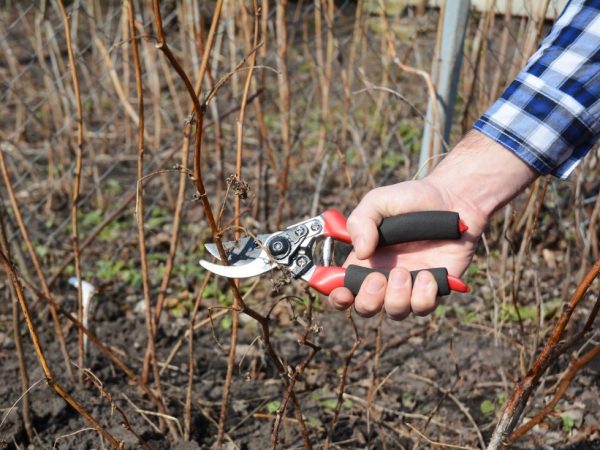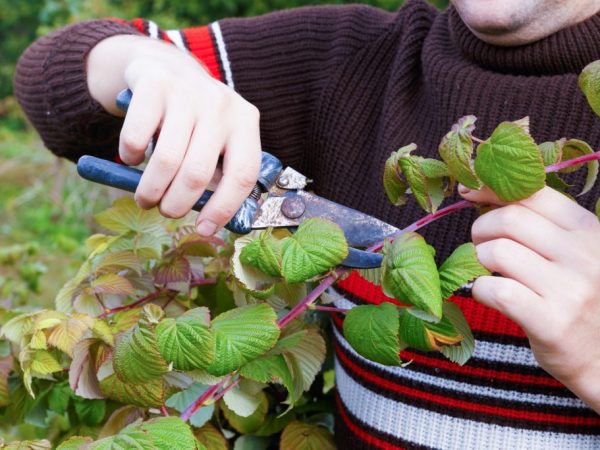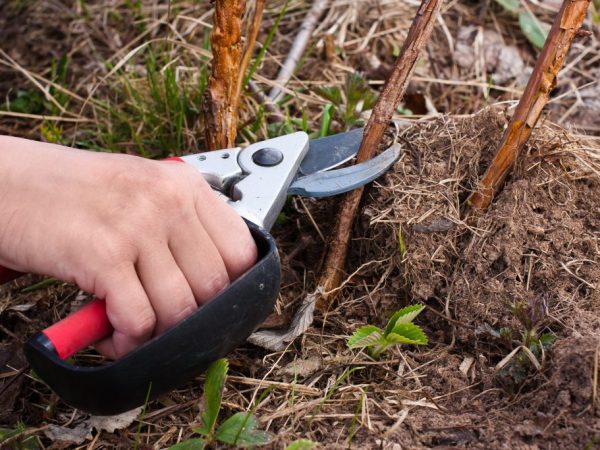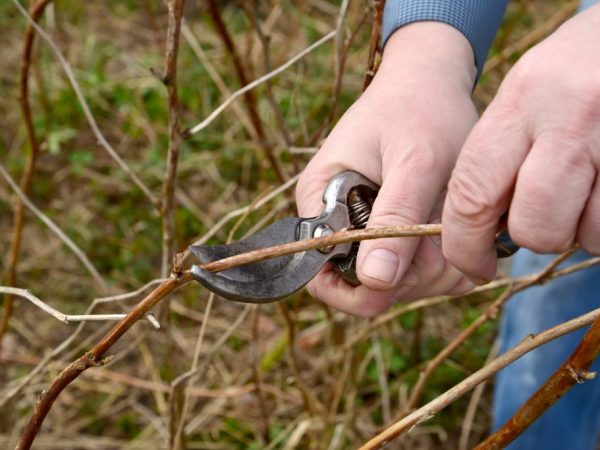We cut remontant raspberries in the fall - the purpose of the procedure and technology
It was not by chance that people composed songs and proverbs about the raspberry-berry. Fragrant, healthy, tasty - leaves no one indifferent. And if it also gives a crop twice a year, it is generally miraculous. But how can this be achieved? Do you need pruning of remontant raspberries in the fall? Let us examine in detail all the frequently asked questions.

We cut remontant raspberries in the fall - the purpose of the procedure and technology
Features of the variety
First you need to figure out how ordinary raspberries differ from remontant ones.
| Variety | Number of harvests | Features of the | Process description |
| Ordinary | One | Two-year development cycle:
| After fruiting, these stems dry out, but new growth appears from the same roots. Dried branches are cut in the fall so that they do not create inconvenience in caring for the plant. |
| Remontant | Two | The varieties are also capable of bearing fruit on the shoots of the first year. | First, the berries appear on last year's stems, then on newly grown bushes. The harvest falls in late June-early July and by the fall the second is ripening. |
In Russia, getting two harvests from remontant raspberries is possible only in the south.
In other areas, fruiting stems of the second year take nutrients from the growing first-year shoots, slowing down their development. The way out of this situation is a one-year growing cycle.
Do I need pruning for the winter
Pruning remontant raspberries in the fall is one of the stages of preparation for winter. Two-year-old stems have fulfilled their task and they are destined to dry out.
If you do not carry out the procedure, the next year's harvest will be small and of poor quality. A plant that has spent a lot of energy will have no resources left to grow a second one before the onset of cold weather.
Optimal timing
Pruning raspberries too early can trigger growth. Here you need to be guided by the principle: better later than before. It is optimal to carry out this operation with the onset of regular frosts.
In the suburbs and the middle lane
In this region, gardeners and gardeners have enough time for autumn work in the country.
Usually shrub pruning begins when the plant sheds its leaves. At this time, they no longer supply the roots with food.
But many people prefer to hold it in October or the first half of November. The main thing is to be in time before the frost.
In the Urals

In the Urals, raspberries are being prepared for winter in September
Even in the Southern Urals, frosts begin in early September. This means that the growing season is over and it's time to get ready for winter.
Repaired raspberries are cut in August, and completely, at the root.
If you delay the procedure, then you can generally lose the bush:
- the stems are dry and brittle due to the lack of moisture in the soil;
- frosts up to 30 ° can be even at the beginning of winter;
- lack of snow cover.
Fragile stems cannot be bent to the ground and covered with snow at least a little, as a result of which uncut shoots will freeze and the whole plant will die.
In Siberia
Even in the warm Altai Territory, frosts occur at the end of August. This means that you need to prepare for winter.
In Siberia, the last days of summer are the best time for pruning. At this time, the culture has already borne fruit and the leaves are falling off.
If autumn turned out to be very warm, you can slightly shift the dates to the beginning of September, but by all means be in time before the first ground frosts. Siberian winters are harsh, so the roots of even winter-hardy varieties can suffer.
To summarize: the Urals and Siberia are not very suitable for growing remontant raspberries. Even in a one-year cycle, there is a high risk of not meeting the growing season. But still, do not give up and give up the double harvest of this berry.
If for some reason it was not possible to prune in the fall, this can be done in the spring. But here the time frame is narrower - this must be done before the start of sap flow.
Lunar calendar
Depending on the phases of the moon, the parameters of processes in living organisms change:
- metabolic rate;
- susceptibility to disease;
- survival of transplanted plants;
- tolerance to cuts and wounds.
On the growing moon, the aerial part (stems, leaves, flowers, fruits) is actively growing. Pruning is not recommended during this phase, during which time injuries to the stems can cause disease.
The underground part develops on a decreasing one (roots, bulbs, tubers). Therefore, the procedure is absolutely safe.

Pruning is best done on a waning moon
New and full moons are the periods when plants are most vulnerable. Pruning raspberries on these days is dangerous. But the day before the new moon and the day after it is a good time to remove damaged and diseased plants, wild growth.
To find out the phase, you can refer to the calendar. For each day, the necessary information is indicated there. There are also special, zoned lunar calendars for gardeners.
In 2019, the most favorable days for pruning:
- August - 16-29;
- September - 15-27;
- October - 15-27;
- November - 13-25.
How to trim properly
Scheme
Depends on the method of cultivation.
One-year cycle
After the end of fruiting, all bushes (and shoots) are cut out at the root.
In the spring, new shoots will go from the roots, which in one season will go through all stages of vegetative development. This is followed by a complete pruning of all bushes.
The advantages of this method:
- ease of plant care;
- effective disease prevention;
- less risk of being hit by pests.
To have fresh berries as long as possible, regular raspberries are grown in parallel with remontant. An early harvest is taken from it.
Two-year cycle (in the south)
Second-year stems can be cut after they have been harvested to free up space and provide additional access to sunlight for first-year shoots. They will develop more intensively.
But there are also disadvantages here. Even after picking the berries, the growing processes in the two-year-old stems continue. They continue to produce and store nutrients for the next season for the entire plant.
General recommendations
It is necessary to remove the stalks of raspberries at the very root, leaving a stump of a minimum height. This should be done with a disinfected sharp pruner. A blunt instrument will scour the branch, which can provoke a fungal disease of the plant.
In order not to injure shoots of different diameters, various tools are used - this can be a delimber or a garden saw.
To reduce the risks of decay, the cut is made obliquely to the outside of the shoot.
It is not necessary to lubricate the sections. For raspberries, this is a natural process, its internal disinfecting substances are able to defeat a small amount of pathogenic microflora. In the wild, branches are constantly broken off by snow, wind or animals - and do not get sick after that.
If the weather is damp, then it is better to process large sections with garden varnish or paint based on drying oil. So it will be calmer that fungi will not get inside.
Follow-up care

All pruned branches must be destroyed
All branches and leaves must be collected and burned. They can nest spores of fungi and insect pests.
When growing raspberries in a two-year cycle, one-year-old stems must be bent to the ground so that they are covered with snow in winter. This is especially important in cold regions.
After pruning and harvesting, the land around the bushes is mulched. It:
- Warms plant roots for the winter, suppresses the growth of weeds.
- In summer, it helps to maintain the necessary moisture in the root layer of the soil. For raspberries, this is especially important, since its entire root system is limited to a layer of 15 cm.
Peat, sawdust, straw, coniferous litter can be used as mulch. It is not recommended to use leaves and grass from the garden - there may be sources of disease.
Summing up
When choosing a remontant variety for planting on your site, it is important to check in advance whether it is zoned in this area.
Raspberries are planted in late September - early October. The plant loves the sun and light soils. If necessary, the land is improved with organic matter: peat, humus, rotted manure.
Top dressing with a full range of mineral fertilizers is carried out twice a season: in spring and in mid-summer. This is a guarantee of a good harvest.
The virtues of culture include:
- It produces a harvest in the first year after planting, which, in particular, allows you to quickly assess the taste of the variety.
- Due to the fact that the entire ground part is removed in autumn, and the remaining root system is easier to cover from the cold, remontant varieties easily tolerate even severe frosts.
- Complete pruning and removal of the entire ground part of the plant makes effective disease and pest control.
- The annual growing cycle greatly simplifies the care of the crop, this is especially important for novice gardeners.
Among the possible disadvantages, we note:
- The taste of berries ripened in autumn with a lack of sun and heat is usually worse than that of ordinary raspberries.
- There is always a risk that the variety will not meet the growing season allotted to it, and at least part of the harvest will be lost.

